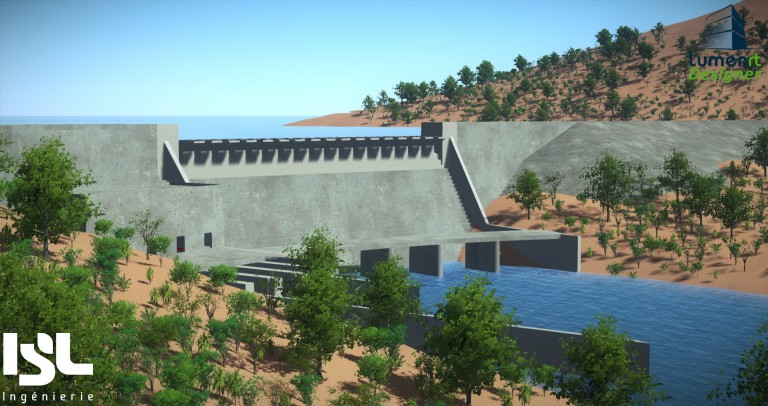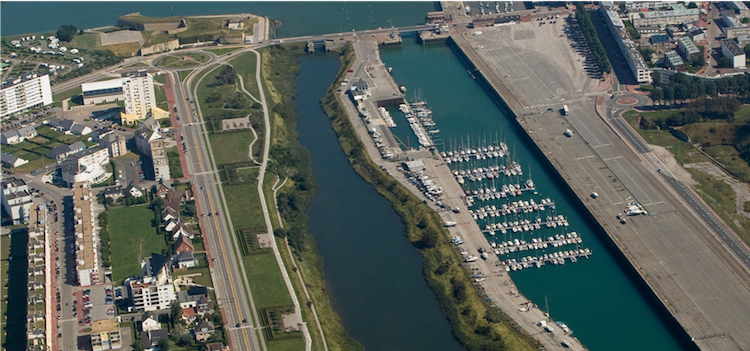Internal erosion, lime treated soils and repair measures in diking system
- 03 February 2022
- Francien Horrevorts
Internal erosion, lime treated soils and repair measures in the diking system of the Calais harbour. What do these topics have in common? They are all part of projects that ISL Ingénierie, one of the Polder2C’s partners, works on. In a recent meeting, ISL presented these projects. Read this summary or watch the full presentation, below.
ISL Ingénierie
ISL Ingénierie is a French engineering office, providing a complete range of services including design, planning, organisation and construction supervision of dams and hydraulic infrastructure projects. Nicolas Nerincx, Project Manager DN&T, and Cédrine Alleon, Sea and Seashore Dept Manager, present several projects of their portfolio to explain the types of questions they advise upon.

R&D projects
ISL Ingénierie regularly invests in R&D projects, by itself or with partners. These projects concern the core business of ISL; dams and hydraulic works. Since 2009, one of ISL's focus topics is levee and dam erosion processes. ISL participated in a French large-scale research programme on internal erosion. The objectives of this project were a better understanding of the internal erosion process and providing operational methods to assess internal erosion and to design internal erosion resistant levees and dams.
The DigueELITE project
From 2013 to 1017 ISL Ingénierie led the DigueELITE project. This is a comprehensive R&D programme with several French partners, on the use of lime treated soils on levees and dams. The project involved laboratory studies, engineering, experimental realisation of a levee and real-scale tests.
Recommendations
As part of the project, overflow tests were done on a levee strip with lime treated soil and a strip with untreated soil. Due to the equipment used, such as a 3D laser scanner, very precise data could be collected related to the state of the levee before, during and after the overflow tests. After analysis of all the data, the research team formulated several design recommendations, to be adapted on a case by case basis:
- Lime treated soil covered by vegetation may replace riprap protection on inland and river slopes of the levee
- Lime treated soil improves the foundation condition of the beam that defines your overflow level
- Lime treated soil is very resistant against internal erosion and limits the need of filters and/or zoned core levee.
- Lime treated soil proves to be efficient to prevent animal burrowing
Repair measures on Calais harbour diking system
Another project that ISL participates in, is a case study about repair measures in the coastal area of Calais. In the harbour of Calais rivers end in the sea through the harbour and a water basin. The latter serves as a reservoir for floods from the land in order to be able to continue draining the lands during the high tide.

The diking system is constituted by an embankment between that reservoir basin and a marina, plus a tidal door at the outlet of the reservoir basin.
The population that is protected by the diking system in the harbour is quite large, so the French regulations require high level of safety. The function of the diking system is to protect people from the water coming from the sea. During high tide the tidal door of the basin is closed. During low tide, it is opened and the water can flow into the sea.
Issues and solution
Due to variable water head on both sides of the structures, some issues arose in the diking system. The groundwater path around the tidal door:
- flows underneath the concrete invert of the tidal door
- flows through cracks and defaults in the invert of the tidal door
- causes washout of the base ground

In the basin, high velocities induced external erosion at the toe of the levee.
In order to solve these issues, ISL proposed the following solution:
- For the tidal door: place a sheet piling on the harbour side in the invert of the door
- For the levee:
- Soften the levee slope to increase the safety coefficient
- Provide protection to the toe of the levee
- Adapt solution to profiles and constraints, mainly near the tidal door
Currently, an environmental study is done to finish the technical proposal for renovating the Calais harbour diking system. After this step ISL Ingénierie can finalise the design prior to the tender procedure for renovation work.
Watch full presentation
Interested in more detailed information on this topic? Watch the full presentation.
Read more
Curious to learn more about ISL Ingénierie and what they do? Read the interview with Nicolas Nerincx and Cédrine Alleon about ISL Ingénierie and their role in Polder2C’s and more.
